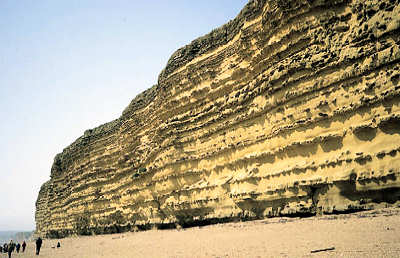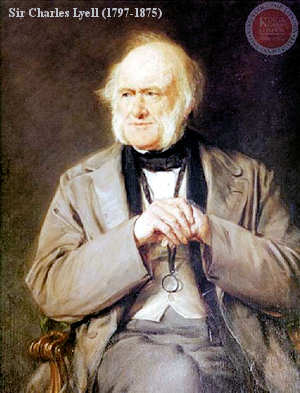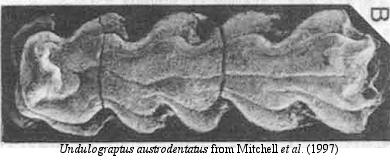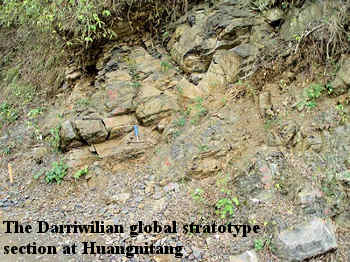
Timescale
| Palaeos: |  |
Geological Timescale |
| Timescale | Stratigraphy |
| Page Back: Geological Timescale | Unit Up: Time | Unit home: Geological Timescale | Page Next: Radiometric dating |
| Unit Back: Historical discovery of Deep Time |
Glossary | References | Unit Next: Chaotian |
 Why
not just use dates? Why do we bother with all these weird names for different
time slices? Actually, almost all of the time periods in the Precambrian are based
on radiometric dates. However, that is changing. As soon as
stratigraphers can find enough information, they will change the simple date
ranges to more complex entities defined in some other way. Are they just
trying to make things more complicated?
Why
not just use dates? Why do we bother with all these weird names for different
time slices? Actually, almost all of the time periods in the Precambrian are based
on radiometric dates. However, that is changing. As soon as
stratigraphers can find enough information, they will change the simple date
ranges to more complex entities defined in some other way. Are they just
trying to make things more complicated?
Actually there are three primary reasons for using this system. The first is simply historical. The science of stratigraphy was born at the same time as geology, early in the Nineteenth Century. Radioactivity was not discovered until a century later (by Roentgen). Thus, the early geologists had no method to determine the absolute dates of the rocks they studied. However, they soon developed quite sophisticated techniques for relative dating. These techniques were developed using sedimentary successions. Mountains are raised by processes deep within the earth which push up molten igneous rock. Sooner or later, this material is worn down by wind, water, and chemical or biological erosion. The rock is eroded into sediment -- sand or dust or gravel -- and settles over a broad area. Most of the earth is covered in layers of sediment, as new sediment settles on top of old sediment. Each layer is compressed by the weight of those above it and becomes sedimentary rock.
 But this layering is consistent. That is, wherever the layers of rock
are exposed -- in a road cut, a steep river valley, a cliff face -- we can be
fairly certain that the sediments get older as we go down the rock column and
younger as we go up. So, looking at any given exposure, we can be quite
sure about relative age. We know that layer A is older than layer
B, even if we have no idea how long ago A and B were deposited. In some cases, things get scrambled and even
reversed, but geologists learned to diagnose these aberrant cases early on, as
these processes leave obvious clues.
But this layering is consistent. That is, wherever the layers of rock
are exposed -- in a road cut, a steep river valley, a cliff face -- we can be
fairly certain that the sediments get older as we go down the rock column and
younger as we go up. So, looking at any given exposure, we can be quite
sure about relative age. We know that layer A is older than layer
B, even if we have no idea how long ago A and B were deposited. In some cases, things get scrambled and even
reversed, but geologists learned to diagnose these aberrant cases early on, as
these processes leave obvious clues.
That works for one cliff face, but how do we compare different exposures? Remember that sediment is usually spread around a broad area. Individual exposures are usually broken into hundreds of individual layers, each of which will have a slightly different color or texture. If we find another cliff face not too far from the first, most of the layers will be the same and we can often compare them visually. This was enough for the earliest stratigraphers to make considerable progress in mapping the geological history of the West of England.
However, when the exposures are separated by hundreds of miles, this system will eventually fail. An intervening ocean or a plate boundary can destroy the physical continuity of the sedimentary layers, making them impossible to compare by inspection alone. Consequently, some other point of comparison is needed, some attribute that spreads more even more widely than the particular color and composition of a particular seam of rock. To serve this need, stratigraphers turned to biostratigraphy. This supplements the sequence of rocks with the sequence of fossils.
 Recall that sediment is created from the top layers of rock, the surface
exposed to air or water. As the sediment settles in the surrounding lower
ground, it is mixed with the shells, bones, and other hard parts of organisms
which happened to die at the same time. Like sediment, these form a
regular succession. Many fossil species are only found over a limited
range within the sedimentary succession and in the same sequence going up or
down the rock column. Animals, partizan those in the seas, are found
over vastly wider areas than the sediment from one particular rock seam.
So, using these biological markers, rock layers across the world can be
correlated with one another.
Recall that sediment is created from the top layers of rock, the surface
exposed to air or water. As the sediment settles in the surrounding lower
ground, it is mixed with the shells, bones, and other hard parts of organisms
which happened to die at the same time. Like sediment, these form a
regular succession. Many fossil species are only found over a limited
range within the sedimentary succession and in the same sequence going up or
down the rock column. Animals, partizan those in the seas, are found
over vastly wider areas than the sediment from one particular rock seam.
So, using these biological markers, rock layers across the world can be
correlated with one another.
When we think of fossils, we often visualize dinosaurs or other large animals. Those are generally too rare to be of much stratigraphic use. Instead, stratigraphers normally use small animals or (more often these days) microfossils. Virtually no sediment created during the last 600 My is so sterile that it completely lacks the remains of these organisms: conodonts, graptolites, tiny mollusk or brachiopod shells, ostracodes, radiolarians, echinoid stem fragments, acritarchs, the rasping teeth of marine worms -- the list goes on and on. Each type is characteristic of a certain time span and each species of each type allows finer determination of the relative date. These have recently been supplemented with non-biological markers, such as magnetic polarity reversals or changes in the isotopic ratios of certain key elements (stable isotopes, not radioisotopes -- this technique is only remotely related to radiometric dating).
 The richness of this record also gets us to the second reason for the
persistence of stratigraphy. Useful microfossils are nearly everywhere.
Useful radioisotopes are not. Isotopes of uranium and thorium are almost
the only materials useful for dating sediments of geologically interesting age.
It takes only tiny amounts, and they need not be at all pure, but volcanic ash
(and not all volcanic ash) is almost the only source from which reliable dates
can be obtained routinely. Thus, stratigraphic relative dates are
considerably easier to get. Fortunately, it takes only one really good
radiometric date, in one location, to provide a solid foundation. The rest
of the world can be dated by biostratigraphic correlation once we have
that one date. So, for example, one well-anchored U-Pb age of 464±2
Ma in Middle Ordovician, associated with fossils of the Undulograptus
austrodentatus Biozone in Argentina (Huff
et al., 1997) allow us to date the beginning of the
Darriwilian Age, all over
the world.
The richness of this record also gets us to the second reason for the
persistence of stratigraphy. Useful microfossils are nearly everywhere.
Useful radioisotopes are not. Isotopes of uranium and thorium are almost
the only materials useful for dating sediments of geologically interesting age.
It takes only tiny amounts, and they need not be at all pure, but volcanic ash
(and not all volcanic ash) is almost the only source from which reliable dates
can be obtained routinely. Thus, stratigraphic relative dates are
considerably easier to get. Fortunately, it takes only one really good
radiometric date, in one location, to provide a solid foundation. The rest
of the world can be dated by biostratigraphic correlation once we have
that one date. So, for example, one well-anchored U-Pb age of 464±2
Ma in Middle Ordovician, associated with fossils of the Undulograptus
austrodentatus Biozone in Argentina (Huff
et al., 1997) allow us to date the beginning of the
Darriwilian Age, all over
the world.
Notice the term "Biozone." Because the microfossil record is rich, we don't have to rely on a single fossil, or even the record of a single species. U. austrodentatus is only found in a narrow slice of the geological record. Even so, it is usually found with or near a characteristic group of other species. These may not be exactly the same everywhere, but there is substantial overlap from place to place, so that we can be extremely sure about where we are in the relative dating scheme. Thus the graptolites Arienigraptus zhejiangensis and Undulograptus sinicus often occur with U. austrodentatus toward the lower and upper parts of its range, respectively. The conodont Microzarkodina parva is often found just below the zone, while another conodont, Histiodella altifrons overlaps the beginning of U. austrodentatus. Similarly various chitinozoans, brachiopods, and mollusks also confirm our date. It may be that no location has all of these species at once, but it would be quite unusual to find any of them in a different relative position, if they occur at all. Typically, fossils appear significantly out of order only when something has been misidentified.
The third reason for retaining this kind of stratigraphy is that it carries so much more information than a raw date. By the time stratigraphers have converged on a particular sequence of species, they are half-way to understanding the ecosystem which produced them. The appearance of more complex graptolites in the Middle Ordovician not only gives us a date, it tells us that an open water pelagic food chain had been established in the waters around the continental shelves. Since graptolites were (and perhaps are -- but that's another story) floating colonial predators, the seas around the continents must have contained a floating population of plankton. The abundance of graptolites might explain, in turn, the Middle Ordovician radiation of nautiloids ... and so on. ATW080304.
 We now turn from how stratigraphy is done in a methodological sense, to how
it is done in an institutional sense. Nineteenth Century stratigraphy was
performed largely by scientific amateurs and surveyors, such as the lawyer, Sir
Charles Lyell. Twentieth Century stratigraphy was
dominated by petroleum geologists. Those groups are interesting, but both
species are largely extinct, or at least endangered. The framework stratigraphy of the world is now being
written (in many cases re-written) by the
International Commission on Stratigraphy
("ICS"), a part of the International
Union of Geological Sciences ("IUGS"). As usual, we will
attempt to skirt political issues. However, it is nearly impossible to say
anything meaningful about institutions without reflecting some personal
judgment.
We now turn from how stratigraphy is done in a methodological sense, to how
it is done in an institutional sense. Nineteenth Century stratigraphy was
performed largely by scientific amateurs and surveyors, such as the lawyer, Sir
Charles Lyell. Twentieth Century stratigraphy was
dominated by petroleum geologists. Those groups are interesting, but both
species are largely extinct, or at least endangered. The framework stratigraphy of the world is now being
written (in many cases re-written) by the
International Commission on Stratigraphy
("ICS"), a part of the International
Union of Geological Sciences ("IUGS"). As usual, we will
attempt to skirt political issues. However, it is nearly impossible to say
anything meaningful about institutions without reflecting some personal
judgment.
The ICS attempts to standardize stratigraphy worldwide and establish a timeline for the Earth which can be globally correlated. The work is split up among Subcommissions which are each responsible for one geological period (="system" for rock geologists), e.g. the Cambrian Subcommission. The ICS subcommissions then undertake what has routinely become a three-step process.
First, the subcommissions each roughed out the epochs ("series") and ages ("stages") within the period. This is an inexact estimate, based on historical usage and slow consensus-building, over years or (in some cases) decades. In the Ordovician example, it was initially uncertain whether there ought to be a Middle Ordovician, or only two epochs. When the Ordovician Subcommission decided on three epochs, there was lengthy debate over whether the Late Ordovician ought to be divided into two ages or three.
Second, the subcommissions decide on a guide event, characteristic, or definition for each time slice (e.g., an ice age, the appearance of a particularly distinctive conodont, a sudden fall in sea level). The subcommission may also propose a name at this point, or may not. Again a consensus is supposed to (and usually does) coalesce around a cluster of events which can be verified over wide areas, marking the beginning of that time. These events are usually the first appearance of new species just before, just after, or dead on the guide event. Increasingly, elements of non-biological stratigraphy are used.
 Finally, one or more groups make a formal proposal to designate a Global
Stratotype Section and Point (GSSP). The GSSP is a particular point at a
particular exposure. Thus, in step 2, the Ordovician Subcommission decided
that the second age of the Middle Ordovician should approximate the appearance
of Undulograptus
austrodentatus, the graptolite we mentioned earlier. Several informal
proposals went nowhere. Ultimately, a group of experts, headed by an American
(Mitchell), proposed using the Australian name ("Darriwilian") and a GSSP in
China. This was published in the ICS official journal, Episodes,
adopted by the subcommission, and ratified by the ICS.
Mitchell et al.
(1997).
Finally, one or more groups make a formal proposal to designate a Global
Stratotype Section and Point (GSSP). The GSSP is a particular point at a
particular exposure. Thus, in step 2, the Ordovician Subcommission decided
that the second age of the Middle Ordovician should approximate the appearance
of Undulograptus
austrodentatus, the graptolite we mentioned earlier. Several informal
proposals went nowhere. Ultimately, a group of experts, headed by an American
(Mitchell), proposed using the Australian name ("Darriwilian") and a GSSP in
China. This was published in the ICS official journal, Episodes,
adopted by the subcommission, and ratified by the ICS.
Mitchell et al.
(1997).
The base of the second age of the Middle Ordovician then became that stratigraphic level which could be correlated with the first appearance of U. austrodentatus at the base of Bed AEP184, 22 m below the top of the Ningkuo Formation where it is exposed in Huangnitang, Changshan, Zhejiang province, southeast China (approx. 28°51'14"N, 118°29'23"E). This GSSP corresponds to a date of about 467.5 Mya, but the date is not part of the definition. The definition is ultimately the operational one of correlation. This requires the proposers to publish detailed charts showing the ranges of other microfossils or events found on or near the proposed GSSP.
A table of the adopted and proposed GSSPs can be found on the ICS website, with links to at least some of the corresponding Episodes articles. An international stratigraphic chart, reflecting current status, updated about once every year, is also available on the same site. The chart is only semi-official, but we have found it quite reliable. ATW080304.
 Finally, there are no rock police. We choose to follow the ICS system
closely, but sometimes deviate. The following is a list of the only four
points on which Palaeos currently deviates from ICS usage for some reason other
than our own sloppiness:
Finally, there are no rock police. We choose to follow the ICS system
closely, but sometimes deviate. The following is a list of the only four
points on which Palaeos currently deviates from ICS usage for some reason other
than our own sloppiness:
1. The Quaternary Period: one of the early acts of the ICS was to abolish the Quaternary. The Quaternary has now been reinstated, but it's base is uncertain. We think it ought to include the Gelasian Age and that its base ought to coincide with the base of the Pleistocene. That is the current ICS position, probably ... Actually, we secretly think the Quaternary ought to be retained only as an informal name for the Pleistocene + Holocene, so that the Neogene runs all the way to last Thursday. In any case, we're not going to use the term at all until things are better sorted out.
2. Cretaceous Epochs: the Cretaceous Period covers the enormous span of 80 My. Yet it has only two epochs, with 5 and 6 ages, respectively. We experimented for a while with a four-epoch system. We're going to give this up, but it may be years before we get back to the Cretaceous to make those changes.
3. Carboniferous "Sub-Periods": No. Never. We will not adopt any sub-, supra-, infra-, uber- etc. time slices. The ICS wants to divide the Carboniferous into two "subsystems," each of three epochs, all but one of which contains only one age. That's absurd. We treat the Mississippian and Pennsylvanian as the only two epochs of the Carboniferous, not as "subsystems."
4. The Hadean Eon & the base of the Archean: The ICS chart starts with the Archean Eon, chronometrically based at 4000 Mya, on the theory that no guide event can be no older than the oldest preserved rock on Earth. This is obsolete thinking, since zircons much older than 4000 Mya exist, and meaningful geology on the pre-Archean has been done using meteorites, isotope ratios, and astronomy. We use the "Hadean" to describe this time, following common informal terminology. We have also suggested some guide events for four component eras. These suggestions will be ignored, of course, but the alternative is to pretend that nothing happened to the Earth before 4000 Mya, which is unacceptable. The nature of the Hadean guide events requires us to trespass marginally on the Archean, which we have moved ever so slightly -- by 200 My. ATW080305.
| Page Back: Geological Timescale | Page Top | Unit Up | Page Next: Radiometric dating |